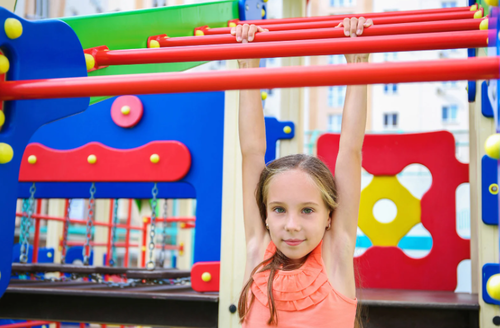Introduction
Choosing the right gymnastics equipment is essential for your child's development. However, some people may unexpectedly find themselves caught in a puzzle when trying to choose between horizontal bars and uneven bars. This guide will explore the differences between horizontal bars and uneven Bars, helping you understand which equipment might be best suited for your child’s needs.
What Are Horizontal Bars and Uneven Bars?
Horizontal bars, also known as high bars, are a single-bar setup. In children's gymnastics, these bars are adapted to provide a platform for developing upper body strength, coordination, and skills in aerial maneuvers.
Uneven bars usually consist of two horizontal bars set at different heights. This equipment challenges gymnasts to perform a seamless flow of movements between the two bars, combining swings, releases, and catches with artistic transitions.
Horizontal Bars vs. Uneven Bars- A Comparative Analysis
Physical Benefits
While both bars contribute significantly to physical development of children, their contributions differ slightly due to their design and the skills that children develop.
- For Horizontal Bars: Exercising with horizon bars can enhance upper body strength—vital for sports that require lifting, pushing, or swinging. Besides, it can help kids develop endurance through repetitive movements, which is beneficial for long-term sports participation.
- For Uneven Bars: Exercising with uneven bars requires gymnasts to change levels and directions, which promotes greater flexibility and coordination. MOreover, the need to perform combinations and transitions helps in developing more complex motor skills.
Cognitive and Emotional Benefits
Training on any gymnastics equipment is mentally and emotionally stimulating, but each type of bar offers unique advantages.
- For Horizontal Bars: Precision and timing required in maneuvers on horizontal bars improve concentration, which is also crucial for academic achievement and problem-solving in daily activities. Additionally, the physical activity involved in exercises like swings and releases on horizontal bars can serve as an effective stress reliever, promoting mental relaxation and the release of mood-enhancing endorphins.
- For Uneven Bars: The complexity of routines on uneven bars necessitates quick thinking and adaptability, enhancing cognitive flexibility and problem-solving skills. Moreover, successfully executing a routine on uneven bars may more easily boost self-confidence, fostering a positive self-image and the determination to tackle challenges.
Choosing the Right Gymnastics Bar for Your Child
Selecting the right gymnastics bar for your child involves more than just picking between horizontal and uneven bars. It requires a comprehensive understanding of various factors that can influence their safety, enjoyment, and development in the sport. Here’s a deeper look into these considerations to ensure you make the best choice for your young athlete.
Age and Skill Level Considerations
When deciding on the right gymnastics bar, consider where your child is in their gymnastics journey:
- Young Beginners: For novices or younger children who are just being introduced to gymnastics, horizontal bars are often recommended. These bars allow for the development of essential gymnastic skills such as swinging, gripping, and basic aerial maneuvers in a simpler and safer environment. The straightforward nature of horizontal bars helps build confidence and foundational skills without the complexity of managing multiple bar heights.
- Advanced Gymnasts: More seasoned gymnasts, especially those who will join competitions, might find uneven bars more beneficial. The uneven bars challenge gymnasts with routines that require coordination between different heights, fostering advanced skills like timing transitions, executing handstands, and perfecting dismounts. These bars simulate real competition settings and encourage athletes to push their boundaries in terms of skill complexity and execution.
Safety Features and Compliance
Ensuring the safety of your child while they practice gymnastics is also very important. Here’s what to look for in the safety features and compliance standards of gymnastics bars:
- Robust Construction: Select bars that are built to withstand the rigors of use without faltering. A solid construction reduces the risk of wobbling or collapsing, which is crucial for the safety of dynamic gymnastic routines.
- Anti-Slip Features: Check for bars with anti-slip feet or bases, which help to stabilize the apparatus during use, preventing sliding and potential accidents.
- Padding and Cushioning: Look for bars that come with adequate padding on hard surfaces and edges. This can include foam covers for the bars themselves and additional matting around the installation area to protect against falls.
Cost vs. Long-Term Investment
- Budget Considerations: Initial cost should be weighed against the expected lifespan and maintenance costs of the bar. Cheaper options might seem appealing but could have higher long-term costs due to replacement or repair needs.
- Investment in Growth: Consider whether the bar can grow with your child. Adjustable models or those that offer extensions to increase height or complexity might provide better long-term value.
Conclusion
Generally, horizontal bars are excellent for building fundamental strength and skills, making them ideal for beginners and younger children. On the other hand, uneven bars present a more complex challenge, suitable for older or more experienced gymnasts looking to refine their technique and perform competitive routines. Making an informed decision will help ensure that the gymnastics bar you choose not only fits your child’s current developmental needs but also supports their growth as a gymnast.

